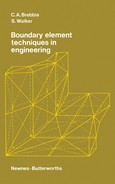
126 ELASTOSTATICS
The fundamental solution used for a three-dimensional isotropic
body is the Kelvin solution and corresponds to a concentrated force
acting at a point in the infinite elastic space. For the displacements it
can be written,
1 f(3-4v)ö
lk t
dr dr
16πΟ(1
— v)
r cx
l
ox
k
where we interpret the derivatives as
dr
=
r
k
dx
k
r
(5.25)
where r
k
are the projections defined in Figure 5.2.
The traction components corresponding to the Kelvin solution are
Ρ
*
β
-8π(1-ννΚ(
(1
"
2ν)
**
+ 3
^έ)
+
. dr dr
+ (1
-
2V)
^-^
(5.26)
n is the normal to the surface of the body.
Equation (5.23) can be specialised for a boundary point in the same
way as the potential problem. Due to the singularities existing in the
left-hand side integrals, we obtain a coefficient such that,
r
hP*k
άΓ +
r
2
CiU+ U
= I MÄdß+ I
p
k
ur
k
dr
+
Ja ύΓ
χ
p
k
uf
k
af
(5.27)
r,
The c
{
coefficient is equal to for a smooth boundary but generally
will be different from this value. Fortunately explicit calculation of
this value is not necessary as it can be obtained using the rigid body
motions in a way similar to that explained in Chapter 2 for potential
problems. We will come back to this in Section 5.4.
5.4 SOURCE APPROACH
Boundary solutions can also be expressed using a source of dipole
type formulation. Here we will discuss only the source one, the other

ELASTOSTATICS
127
formulation
can
equally well
be
deduced
as was
done
for
potential
problems.
Consider for
a
moment that all the boundary is of the type
Γ
ί
with a
value
of
the displacements equal
to
u
k
(displacements for an external
field). This field also has some components
of
surface tractions that
can
be
calculated from
u
k
and are
called
p
k
.
Hence equation (5.23)
becomes,
28)
«;+
[
u
kP
r
k
dr
= ί
b
k
uf
k
aQ+
I
p
k
u*
k
ar
(5.
Jr
Jß Jr
From the special form of the divergence theorem for this case we can
write,
f n
kP
r
k
dr= {p
k
ur
k
dr (5.29)
Thus equation (5.28) can
be
written,
«i
= f
(P*
~ PkX άΓ + f
b
k
uf
k
άΓ
(5.30)
where p
k
-
p
k
is
defined
as the φ
κ
source and formula (5.30) can
be
written
u=
Φ^άΓ+
k
ur
k
άΓ
(5.31)
The value
of
the force components can
now be
deduced
as
Pi
= ί
Φι
P?
k
dr
+
b
k
pf
k
dr (5.32)
Equation (5.31) presents a singularity when the point is taken to the
boundary.
Its
final version gives
for a
smooth boundary,
P
= ~Φί+ ί « άΓ + ί
b
k
uf
k
άΓ
(5.33)
Formulae (5.32)
and
(5.33)
can be
used
to
solve
the
problem
expressed in terms of σ sources. If we start with a
Γ
2
type of boundary
one will arrive
at the
dipole formulation. Although
we
have started
here assuming that the boundary was
Γ
1
type, we can solve in terms of
known
p's and u's
using
the
above formulae.
..................Content has been hidden....................
You can't read the all page of ebook, please click here login for view all page.
